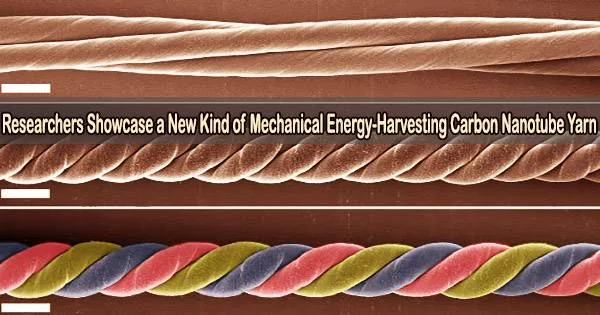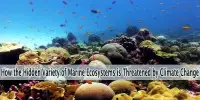Researchers in nanotechnology at The University of Texas at Dallas have created unique carbon nanotube yarns that are more efficient than other material-based energy harvesters at converting mechanical action into electricity.
Researchers from UT Dallas and its associates report advancements to high-tech yarns they created termed “twistrons,” which generate electricity when stretched or twisted, in a study published January 26, 2023, in Nature Energy. Their novel design is built similarly to conventional wool or cotton yarns.
When used in salt water, twistrons can capture energy from the motion of the ocean waves, and twistrons can even charge supercapacitors. Twistrons can sense and harvest human motion when woven into fabrics.
First described by UTD researchers in a study published in 2017 in the journal Science, twistrons are constructed from carbon nanotubes (CNTs), which are hollow cylinders of carbon 10,000 times smaller in diameter than a human hair. Twist-spun nanotubes are made into high-strength, thin fibers or yarns, which can also contain electrolytes, to create twistrons.
The researchers achieved the strong elastic properties of earlier twistrons by adding so much twist that the yarns coil like an excessively twisted rubber band. The coiled strands are repeatedly stretched and released, or they are twisted and untwisted, to produce electricity.
In the new study, the research team did not twist the fibers to the point of coiling. Instead, scientists created a single yarn by weaving together three separate strands of spun carbon nanotube fibers, which is similar to how regular yarns used in textiles are made but with a unique twist.
Our materials do something very unusual. When you stretch them, instead of becoming less dense, they become more dense. This densification pushes the carbon nanotubes closer together and contributes to their energy-harvesting ability. We have a large team of theorists and experimentalists trying to understand more completely why we get such good results.
Dr. Ray Baughman
“Plied yarns used in textiles typically are made with individual strands that are twisted in one direction and then are plied together in the opposite direction to make the final yarn. This heterochiral construction provides stability against untwisting,” said Dr. Ray Baughman, director of the Alan G. MacDiarmid NanoTech Institute at UT Dallas and the corresponding author of the study.
“In contrast, our highest-performance carbon-nanotube-plied twistrons have the same-handedness of twist and plying they are homochiral rather than heterochiral,” said Baughman, the Robert A. Welch Distinguished Chair in Chemistry in the School of Natural Sciences and Mathematics.
In experiments with the plied CNT yarns, the researchers demonstrated an energy conversion efficiency of 17.4% for tensile (stretching) energy harvesting and 22.4% for torsional (twisting) energy harvesting. Their coiled twistrons’ peak energy conversion efficiency in earlier iterations was 7.6% for combined tensile and torsional energy harvesting.
“These twistrons have a higher power output per harvester weight over a wide frequency range between 2 Hz and 120 Hz than previously reported for any non-twistron, material-based mechanical energy harvester,” Baughman said.
According to Baughman, the lateral compression of the yarn during stretching or twisting is the reason for the plied twistrons’ increased performance. The interaction of the plies during this procedure changes the yarn’s electrical characteristics.
“Our materials do something very unusual,” Baughman said. “When you stretch them, instead of becoming less dense, they become more dense. This densification pushes the carbon nanotubes closer together and contributes to their energy-harvesting ability. We have a large team of theorists and experimentalists trying to understand more completely why we get such good results.”
The best performance, according to the researchers, was achieved by making the yarn from three plies.
The group used three-ply twistrons in a number of proof-of-concept tests. In one experiment, they attached a three-ply twistron between a balloon and the saltwater aquarium’s bottom to imitate the creation of electricity from ocean waves.
They also assembled severally plied twistrons into a tiny array that weighs only 3.2 milligrams, stretched them repeatedly, and used the energy they stored in the supercapacitor to power five miniscule light-emitting LEDs, a digital timepiece, and a digital humidity/temperature sensor.
A cotton fabric patch that had the CNT yarns stitched onto it was also created by the team and was later wrapped around a person’s elbow. The individual continually bending their elbow demonstrated the potential application of the fibers for monitoring and extracting human motion.
The researchers have applied for a patent based on the technology.
Other NanoTech Institute researchers involved in the work are co-lead authors Dr. Mengmeng Zhang, research associate, and Dr. Wenting Cai, former visiting scientist; Zhong Wang PhD’21, research associate; Dr. Shaoli Fang, associate research professor; Dr. Ali E. Aliev, research professor; Dr. Anvar Zakhidov, deputy director of the institute and professor of physics; and Dr. Jiyoung Oh, research scientist.
Other contributors from UTD were Runyu Zhang, mechanical engineering doctoral student, and Dr. Hongbing Lu, professor of mechanical engineering.
Researchers from Xi’an Jiaotong University and Wuhan University in China, Hanyang University in South Korea, and Lintec of America Inc.’s Nano-Science & Technology Center also contributed.
The U.S. Navy, the Air Force Office of Scientific Research, The Welch Foundation, the National Science Foundation, and the Department of Energy all provided funding for the study.















